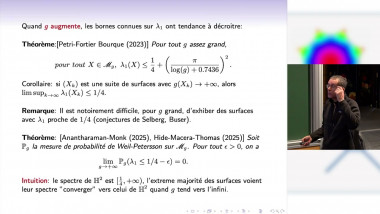
Problèmes ouverts et progrès récents en géométrie spectrale hyperbolique
De Frédéric Naud
Apparaît dans la collection : PRACQSYS 2018: Principles and Applications of Control in Quantum Systems
Building large controlled quantum systems is a very exciting challenge of modern physics, and a necessary milestone to fulfill the promises of the second quantum revolution. Arrays of neutral atoms have recently emerged as a versatile tool in this context, building on the high coherence properties of atomic systems and on the mature experimental toolbox of cold-atom physics. In this talk, I will describe two experimental approaches towards scalable many-body quantum systems based on neutral atoms with single-particle control and long-range interactions. In the first approach, pursued at Harvard University in the group of Mikhail Lukin, we use arrays of individual atoms trapped in movable optical tweezers and interacting through a Rydberg state. With this platform, we were able to perform quantum simulations of a 51-qubit Ising Hamiltonian, where classical simulations are no longer tractable, and to observe some intriguing quantum many-body dynamics effects after a sudden quench [1]. In a second approach, pursued at Laboratoire Kastler Brossel in the group of Jakob Reichel, we will load single atoms in an optical lattice trap sustained by a fiber-based Fabry-Perot cavity placed under a quantum gas microscope, with cavity-mediated interactions. With this platform, we plan to study various protocols for the creation and characterization of many-body entanglement, such as the Dicke model where highly entangled states are expected to occur in the vicinity of the quantum phase transition. I will discuss how these two platforms could benefit from optimal control techniques [2], for example to create large-scale entangled states on the Rydberg atom array experiment.
